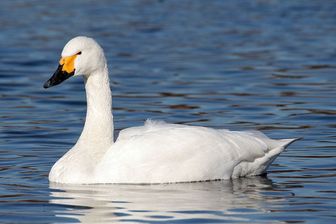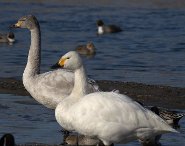Whistling Swan
C. c. bewickii , Bewick's Swan C. c. columbianus , Whistling Swan

Original source: photo taken by Maga-chan
Author: Maga-chanPermission(Reusing this file)Maga-chan put it under the Cc-by-sa
 The Tundra Swan/Whistling Swan (Cygnus columbianus) is an all-white bird of amazing grace and beauty. Its bill is black, sometimes with a yellow spot at the base. The legs and feet are also black. While both genders are identical in appearance, the male is usually just a bit larger.
The Tundra Swan/Whistling Swan (Cygnus columbianus) is an all-white bird of amazing grace and beauty. Its bill is black, sometimes with a yellow spot at the base. The legs and feet are also black. While both genders are identical in appearance, the male is usually just a bit larger.
Measurements for both sexes are as follows:
Length: 47.2-57.9 in/120-147 cm
Wingspan: 66.1 in/168 cm
Weight: 134-370.4 oz /3800-10500 g
Although this animal is more commonly called the Tundra Swan, it has also been known as the Whistling Swan. This does not refer to the call of the bird - which is a low, melodic sound. Instead, it refers to the sound the bird’s powerful wings make in flight.
The migration of this swan is an incredible 3,725 miles (6,000 kilometers) round trip. True to its name, it breeds in the wet and cold Arctic tundra. The eastern population then heads to the Chesapeake Bay and North Carolina while the western population winters in primarily in California.
Tundra swans are believed to mate for life. They choose their mates for up to a year before breeding and the pair reinforces its bond through visual and vocal displays. While these animals flock together during migration, they are solitary nesters, often choosing a site near a pond, slow-moving river, or stream. The nest is assembled from a variety of plant material including sticks, moss and sedges. An excellent nesting site may be used year after year by the same birds.
The female usually lays four to five eggs and incubates them for about a month with some help from the male. After the eggs hatch both parents tend to the young swans and lead them to food sources. Although the young can fly at two to three months of age, they usually stay with the parents through the first winter.
The two parents are formidable opponents for most predators. Usually they can defend their nests against foxes and weasels. Larger predators like wolves, bears or even people will cause the parents to quickly leave the nest. This may still help to save the young as leaving quickly makes the nest more difficult to find.
The Tundra Swan population is very stable and hunting is allowed in some areas. The birds are very adaptable as well. Traditionally, the swan has primarily eaten aquatic roots and tubers, as well as shellfish. More recently these creatures have developed a taste for grains and corn, ensuring a well-fed, thriving population.
Picture of the Tundra swan by Maga-chan, licensed under Creative Commons Attribution-Share Alike 2.5 Generic
The Whistling Swan is classified as Least Concern. Does not qualify for a more at risk category. Widespread and abundant taxa are included in this category.


